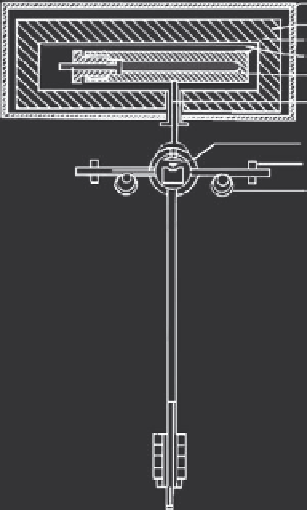Geoscience Reference
In-Depth Information
Figure 3.18 Fundamental arrangement
of horizontal autoclaves
[52]
.
1
2
3
4
5
6
7
8
9
1. Horizontal autoclave
2. Furnace
3. Vertical axle
4. Metallic safe
5. Triangular prism
6. Ring
7. Counter weight
8. Horizontal axles
9. Balance weights
Horizontal Autoclaves for Controlled Growth of Crystals
This autoclave is highly sensitive to the displacement of mass from the nutrient
zone to the growth zone through the arrangement of a highly sensitive balance sys-
tem.
Figure 3.18
shows the fundamental arrangement. The main part of the unit is
a horizontal autoclave mounted at the center of gravity on the vertical axle. The
autoclave freely swings in the furnace and the deflection of the axle from
the vertical indicates a shift of the mass inside the autoclave from one side to the
other. Special weighing scales make it possible to estimate the amount of
displaced material, and additional weights help to return the autoclave to a hori-
zontal position.
Thus, by carrying out experiments in the balance system, one can obtain contin-
uous information regarding the motion of mass in the autoclave and know when
homogenization of the medium sets in. Also, information regarding whether recrys-
tallization of the material is taking place, or at what velocity the recrystallization is
proceeding can be obtained. If crystals are being grown on seeds with a pre-
specified area, it would be possible to calculate the rate of growth of the crystals
and to regulate this by varying the temperature difference between the dissolution
and growth zones.
Shternberg
[52]
designed and fabricated this autoclave. He has also standardized
this system to study the spontaneous crystallization of sphalerite, recrystallization
of sodalite, solubility isochore of potassium niobate crystals, and so on.


